
Darmstadt

Twinned with Chesterfield in the UK, Darmstadt is a city in the Bundesland
(federal state) of Hessen in Germany . As of 2010, its population was 143,300.
Darmstadt is also twinned with:
- Alkmaar, Netherlands
- Brescia, Ital
- Bursa, Turkey
- Graz, Austria
- Liepaja, Latvia
- Logroño, Spain
- Plock, Poland
- Szeged, Hungary
- Trondheim, Norway
- Troyes, France
- Uzhgorod, Ukraine
The city is located to the south of the metropolitan areas of Frankfurt and Wiesbaden. And in 1997 it was officially awarded the designation Wissenschaftsstadt ("city of sciences"). It is home to a large technology institute, the TU Darmstadt, which is one of the important technical institutes in the Hessen region and is well known for its research in the disciplines of electrical and mechanical engineering. But it is best known as a high-tech centre, with important activities in spacecraft operations, chemistry, information technology, biotechnology and mechatronics.
Scientific institutes in the area are the Gesellschaft für Schwerionenforschung and the three Institutes of the Fraunhofer Society . The European Space Operations Center (ESOC) of the European Space Agency is located in Darmstadt, as is EUMETSAT, which operates meteorological satellites . Darmstadt is also a centre for the pharmaceutical and chemical industry, with Merck and Röhm having their main plants and centres here.
Literally translated, the German name "Darmstadt" means "City of the intestine".
But that is just an unfortunate coincidence, as the name derives from the medieval
name "darmundestat", meaning "Place at the mouth of the Darmbach." (Darmstädter
unhappy with the city name traditionally seek solace in the fact that their
city is not named Düsseldorf).
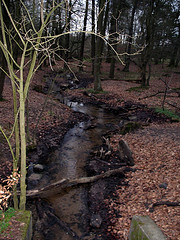
The Darmbach is said to have given Darmstadt its name.
However, Darmstadt is also notable for its culture. Classical music, art exhibitions and a lively theatre scene all contribute to Darmstadt's charm.
The Internationales Musikinstitut Darmstadt, harbours one of the world's largest collections of post-war sheet music, also hosts the biannual summer school Internationale Ferienkurse für Neue Musik. These courses were founded by Wolfgang Steinecke, and ran first annually, then bi-anually. A large number of avant-garde composers have given lectures there, including Olivier Messiaen, Luciano Berio, Milton Babbitt, Pierre Boulez, John Cage, György Ligeti, Iannis Xenakis, Karlheinz Stockhausen and Mauricio Kagel.
It is also home to the Deutsche Akademie für Sprache und Dichtung (German Academy for Language and Poetry), which provides writers and scholars with a place to research the German language. The Academy's annual Georg-Büchner-Preis, named in memory of Georg Büchner, is considered the most renowned literary award for writers of German language.

History of Darmstadt
The name Darmstadt first appears towards the end of the 11th century , then Darmundestat ; Darmstadt was chartered as a city by the Emperor Ludwig the Bavarian in 1330. The seat of the ruling landgraves ( 1567 - 1806 ) and thereafter (to 1918) grand dukes of the state of Hessen-Darmstadt, the city grew in population during the 19th century from little over 10,000 to 72,000 inhabitants. A Technical University was established in 1877.
In the begin of the 20th Century Darmstadt was an important centre for the art movement of Jugendstil , the German variant of Art Nouveau . Annual architectural competitions led to the building of many architectural treasures of this period.
Darmstadt's municipal area was extended in 1937 to include the neighbouring localities of Arheilgen [not Arheil i gen] and Eberstadt, and in 1938 the city was separated administratively from the surrounding district ( Kreis ). Its old city centre was largely destroyed in a British bombing raid of September 11th 1944, which killed an estimated 12,300 inhabitants and rendered 66,000 homeless. Most of Darmstadt's 3000 Jews were killed by the Nazi regime between 1933 and 1945.
More recently in 2003, the chemical element Darmstadtium (atomic number : 110), which was first discovered at the Gesellschaft für Schwerionenforschung was named after the city in 2003, making Darmstadt only the fourth city with an element named after it (the other three are Ytterby, Sweden, Berkeley, California, and Dubna, Russia). Meitnerium (atomic number : 109) was also synthesized in this facility in 1982.

Sightseeing
The Waldspirale (see above) is the name of an appartment block in Darmstadt. It doesn't sound exciting, but it's one of my favourite buildings. Built in the 1990s the name translates into English as "spiral forest", to reflect both the general plan of the building and the fact that it has a green roof. It was designed by Viennese artist Friedensreich Hundertwasser, built by the Bauverein Darmstadt company, and planned and implemented by the architect Heinz M. Springmann. The building was completed in 2000.
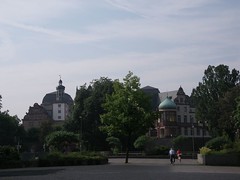
The palace of Darmstadt (Schloß) is located in the city centre. It was the residence of the counts of Hesse-Darmstadt, Grand Dukes of Hesse by the grace of Napoleon. Its current look was established in the 18th century. The counts also owned a castle on the Langenberg above the city. This castle dates back to the 13th century, but it was acquired by the counts of Hessen-Darmstadt in 1662. The name of the castle is Frankenstein. Mary Shelley probably adopted the name for her novel Frankenstein, as before writing the story she had travelled through the region and visited Eberstadt (today a borough of Darmstadt), so the castle could have given her the inspiration.
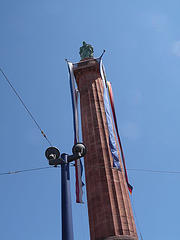
Long Ludwig is right in the centre.
The Luisenplatz , the largest square of the city, forms the centre of the town. Today it is surrounded by modern buildings. In 1844 the Ludwigsäule (called Langer Lui , meaning Long Ludwig ), a 33-meter column commemorating Ludwig I, first Grand Duke of Hessen, was placed in the middle. The other large town square is the Marktplatz (see image) near the town hall; it was restored in 1996 to regain the look that it had before World War II.
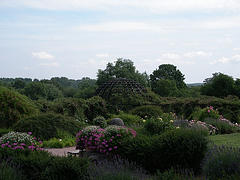
A view over the gardens.
The Rosenhöhe
(Rose Heights) is a beautiful garden, which was previously a vineyard in the
possession of the royal house. It was transformed into a landscaped garden
in the English style at the beginning of the 19th century. The royal architect
Georg Moller decorated the park with tea-houses and pavilions, some of which
can still be viewed, but unfortunately no tea is served.
An absolute must see is the Mathildenhöhe which hosts contemporary art
exhibitions in its large exhibition halls, along with a static exhibition in
the museum, which is dedicated to Jugendstil (art nouveau).
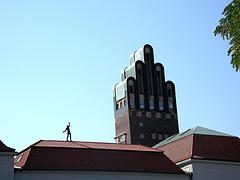
The Hochzeitsturm and exhibition centre.
The distinctive Hochzeitsturm [Marriage tower],
commonly known as the Five-Finger-Tower. Just wondering around the area you
can see many private villas built by Jugendstil architects who had settled
in Darmstadt.
And the nearby Russian Chapel, which was built as a private chapel for
the last Tzar of Russia, is well worth a visit.
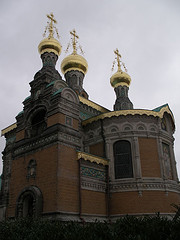
The Russian Chapel
The Jazz-Institut Darmstadt is Germany's largest publicly accessible Jazz archive.
All text is available under the terms of the GNU Free Documentation License.
All photos are mine.








